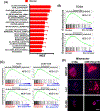Modulation of oxidative phosphorylation and mitochondrial biogenesis by cigarette smoke influence the response to immune therapy in NSCLC patients
- PMID: 36773459
- PMCID: PMC10065953
- DOI: 10.1016/j.lungcan.2023.01.016
Modulation of oxidative phosphorylation and mitochondrial biogenesis by cigarette smoke influence the response to immune therapy in NSCLC patients
Abstract
The treatment regimen of non-small cell lung cancer (NSCLC) has drastically changed owing to the superior anti-cancer effects generated by the immune-checkpoint blockade (ICB). However, only a subset of patients experience benefit after receiving ICBs. Therefore, it is of paramount importance to increase the response rate by elucidating the underlying molecular mechanisms and identifying novel therapeutic targets to enhance the efficacy of IBCs in non-responders. We analyzed the progression-free survival (PFS) and overall survival (OS) of 295 NSCLC patients who received anti-PD-1 therapy by segregating them with multiple clinical factors including sex, age, race, smoking history, BMI, tumor grade and subtype. We also identified key signaling pathways and mutations that are enriched in patients with distinct responses to ICB by gene set enrichment analysis (GSEA) and mutational analyses. We found that former and current smokers have a higher response rate to anti-PD-1 treatment than non-smokers. GSEA results revealed that oxidative phosphorylation (OXPHOS) and mitochondrial related pathways are significantly enriched in both responders and smokers, suggesting a potential role of cellular metabolism in regulating immune response to ICB. We also demonstrated that all-trans retinoic acid (ATRA) which enhances mitochondrial function significantly enhanced the efficacy of anti-PD-1 treatment in vivo. Our clinical and bioinformatics based analyses revealed a connection between smoking induced metabolic switch and the response to immunotherapy, which can be the basis for developing novel combination therapies that are beneficial to never smoked NSCLC patients.
Keywords: Cigarette smoke; Immune therapy; NSCLC; Oxidative phosphorylation.
Copyright © 2023 Elsevier B.V. All rights reserved.
Conflict of interest statement
Declaration of Competing Interest The authors declare that they have no known competing financial interests or personal relationships that could have appeared to influence the work reported in this paper.
Figures






Similar articles
-
Oncogene-specific differences in tumor mutational burden, PD-L1 expression, and outcomes from immunotherapy in non-small cell lung cancer.J Immunother Cancer. 2021 Aug;9(8):e002891. doi: 10.1136/jitc-2021-002891. J Immunother Cancer. 2021. PMID: 34376553 Free PMC article.
-
Spatial transcriptomics of macrophage infiltration in non-small cell lung cancer reveals determinants of sensitivity and resistance to anti-PD1/PD-L1 antibodies.J Immunother Cancer. 2022 May;10(5):e003890. doi: 10.1136/jitc-2021-003890. J Immunother Cancer. 2022. PMID: 35618288 Free PMC article.
-
PD-L1 Expression, Tumor Mutational Burden, and Cancer Gene Mutations Are Stronger Predictors of Benefit from Immune Checkpoint Blockade than HLA Class I Genotype in Non-Small Cell Lung Cancer.J Thorac Oncol. 2019 Jun;14(6):1021-1031. doi: 10.1016/j.jtho.2019.02.008. Epub 2019 Feb 16. J Thorac Oncol. 2019. PMID: 30780001
-
Safety and Efficacy of PD-1/PD-L1 inhibitors combined with radiotherapy in patients with non-small-cell lung cancer: a systematic review and meta-analysis.Cancer Med. 2021 Feb;10(4):1222-1239. doi: 10.1002/cam4.3718. Epub 2021 Jan 19. Cancer Med. 2021. PMID: 33465302 Free PMC article.
-
Response Rate and Survival at Key Timepoints With PD-1 Blockade vs Chemotherapy in PD-L1 Subgroups: Meta-Analysis of Metastatic NSCLC Trials.JNCI Cancer Spectr. 2021 Jan 27;5(3):pkab012. doi: 10.1093/jncics/pkab012. eCollection 2021 Jun. JNCI Cancer Spectr. 2021. PMID: 34084999 Free PMC article.
Cited by
-
The Benefits and Safety of Monoclonal Antibodies: Implications for Cancer Immunotherapy.J Inflamm Res. 2025 Mar 24;18:4335-4357. doi: 10.2147/JIR.S499403. eCollection 2025. J Inflamm Res. 2025. PMID: 40162076 Free PMC article. Review.
-
A patient stratification signature mirrors the immunogenic potential of high grade serous ovarian cancers.J Transl Med. 2024 Nov 20;22(1):1048. doi: 10.1186/s12967-024-05846-9. J Transl Med. 2024. PMID: 39568014 Free PMC article.
-
Energy metabolism as the hub of advanced non-small cell lung cancer management: a comprehensive view in the framework of predictive, preventive, and personalized medicine.EPMA J. 2024 Apr 8;15(2):289-319. doi: 10.1007/s13167-024-00357-5. eCollection 2024 Jun. EPMA J. 2024. PMID: 38841622 Free PMC article. Review.
-
Common immunological and prognostic features of lung and bladder cancer via smoking-related genes: PRR11 gene as potential immunotherapeutic target.J Cell Mol Med. 2024 May;28(10):e18384. doi: 10.1111/jcmm.18384. J Cell Mol Med. 2024. PMID: 38760964 Free PMC article.
References
-
- Wahid B, Ali A, Rafique S, Waqar M, Wasim M, Wahid K, Idrees M, An overview of cancer immunotherapeutic strategies, Immunotherapy 10(11) (2018) 999–1010. - PubMed
-
- Hamid O, Robert C, Daud A, Hodi FS, Hwu WJ, Kefford R, Wolchok JD, Hersey P, Joseph R, Weber JS, Dronca R, Mitchell TC, Patnaik A, Zarour HM, Joshua AM, Zhao Q, Jensen E, Ahsan S, Ibrahim N, Ribas A, Five-year survival outcomes for patients with advanced melanoma treated with pembrolizumab in KEYNOTE-001, Ann Oncol 30(4) (2019) 582–588. - PMC - PubMed
-
- Garon EB, Rizvi NA, Hui R, Leighl N, Balmanoukian AS, Eder JP, Patnaik A, Aggarwal C, Gubens M, Horn L, Carcereny E, Ahn MJ, Felip E, Lee JS, Hellmann MD, Hamid O, Goldman JW, Soria JC, Dolled-Filhart M, Rutledge RZ, Zhang J, Lunceford JK, Rangwala R, Lubiniecki GM, Roach C, Emancipator K, Gandhi L, Pembrolizumab for the treatment of non-small-cell lung cancer, N Engl J Med 372(21) (2015) 2018-28. - PubMed
-
- Rini BI, Plimack ER, Stus V, Gafanov R, Hawkins R, Nosov D, Pouliot F, Alekseev B, Soulieres D, Melichar B, Vynnychenko I, Kryzhanivska A, Bondarenko I, Azevedo SJ, Borchiellini D, Szczylik C, Markus M, McDermott RS, Bedke J, Tartas S, Chang YH, Tamada S, Shou Q, Perini RF, Chen M, Atkins MB, Powles T, Pembrolizumab plus Axitinib versus Sunitinib for Advanced Renal-Cell Carcinoma, N Engl J Med 380(12) (2019) 1116–1127. - PubMed
Publication types
MeSH terms
Substances
Grants and funding
LinkOut - more resources
Full Text Sources
Medical

